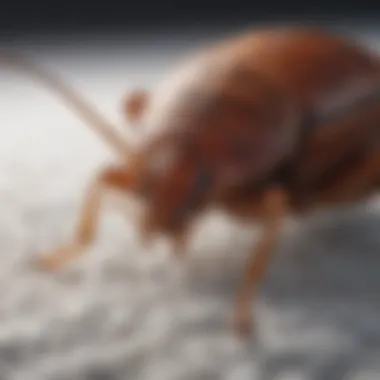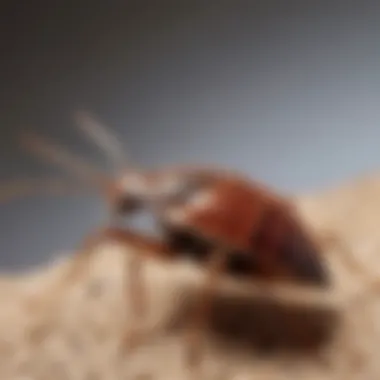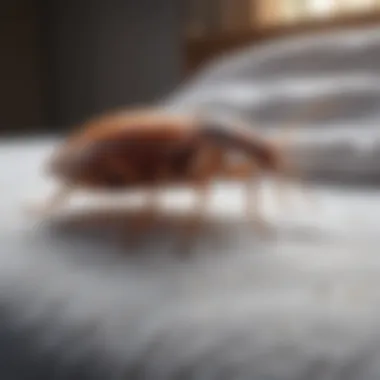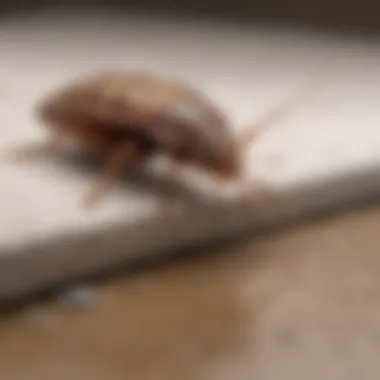Investigating Freezing as a Bed Bug Control Method


Intro
Bed bugs are a pervasive nuisance in many homes. Their ability to reproduce quickly and hide in hard-to-reach places makes them difficult to manage. Traditional methods of extermination often rely on chemical treatments. However, there is a growing interest in alternative methods, such as freezing, for their effectiveness in bed bug control. This article investigates the viability of low-temperature treatments and provides practical approaches for homeowners.
Understanding Pests
Definition of Pests
Pests are organisms that cause harm or discomfort to humans, animals, or plants. They can include insects, rodents, and other animals that invade living spaces. Bed bugs are a particular concern due to their nature of feeding on human blood. These small, brown insects are often found in beds, furniture, and other areas where people sleep or rest.
Importance of Pest Identification
Identifying pests is critical for effective control. Knowing the species can guide the selection of appropriate treatment options. Bed bugs are notoriously resilient. Their eggs can survive extreme conditions, making accurate detection vital. Homeowners should look for signs such as bites, shell casings, and dark spots on bedding. Understanding the life cycle of bed bugs can also inform effective treatment strategies.
Freezing as a Control Method
Freezing is an increasingly popular method for eliminating bed bugs. Research suggests that exposure to temperatures below 0°F (-18°C) for a specific duration can kill bed bugs at all life stages. This method presents an alternative for those who prefer to avoid chemical treatments. However, understanding the limits is essential. For success, items need to remain at freezing temperatures for at least several hours.
Critical Temperatures for Elimination
To achieve effective results, ensure the following conditions:
- Temperature: Use a thermometer to maintain a steady temperature of 0°F.
- Duration: Keep the infested items frozen for at least four days. This will effectively kill both adults and juvenile bed bugs.
"Freezing is a viable alternative but demands precise temperature control over time for full efficacy."
Practical Considerations for Homeowners
While freezing can be effective, several factors must be considered:
- Applicability: Not all items are suitable for freezing. Ensure that textiles and other materials can withstand low temperatures.
- Preparation: Before freezing, pack items in airtight plastic bags. This prevents moisture from accumulating, which could render the treatment ineffective.
Eco-Friendly Pest Control Solutions
Overview of Sustainable Practices
Sustainable and eco-friendly practices are increasingly important to many homeowners. These practices not only help in pest control but also contribute to overall environmental health. Freezing can be considered a sustainable option since it does not introduce harmful chemicals into the home.
Natural Remedies and Their Effectiveness
In addition to freezing, various natural remedies can help deter bed bugs:
- Diatomaceous Earth: This powder can dehydrate bed bugs on contact. It’s essential to apply it in cracks and crevices.
- Essential Oils: Certain oils may repel bed bugs, although their effectiveness can vary.
Prelude to Bed Bugs
Bed bugs are more than just a nuisance; they represent a serious challenge for many households. Understanding them is crucial for effective pest management. This section will delve into critical components that define bed bugs, investigate their behavior, and outline the health risks they pose. This knowledge sets the foundation for evaluating freezing as a pest control method.
Defining Bed Bugs
Bed bugs, scientifically known as Cimex lectularius, are small, nocturnal insects that feed on the blood of humans and animals. These pests are typically reddish-brown in color and approximately the size of an apple seed. They are elusive and can hide in various crevices, making them hard to detect. Their definition extends beyond the physical description to include their resilience; they can survive for several months without feeding, complicating control measures.
Understanding Bed Bug Behavior
The behavior of bed bugs significantly influences their management. They are primarily active at night, which is when they emerge from their hiding spots to feed. Their preference for close proximity to human hosts makes them prevalent in settings like homes, hotels, and hostels. Bed bugs are known for their ability to disperse and spread quickly, often hitching rides on personal belongings or used furniture.


They are also capable of sensing carbon dioxide and body heat, which directs them to their next meal. Understanding these behaviors is essential for householders aiming to implement effective prevention and control strategies.
Health Risks Associated with Bed Bugs
While bed bugs are not known to transmit diseases, their bites can cause significant discomfort and anxiety. Many individuals experience allergic reactions, resulting in itchy welts and skin infections from excessive scratching. The presence of bed bugs often leads to sleep disturbances and psychological stress due to the fear of being bitten.
Monitoring these health risks is vital for individuals and families affected by infestations. Ensuring awareness of the possible physical and emotional consequences of bed bug encounters emphasizes the importance of exploration into various control methods, including freezing.
The Science Behind Freezing
Understanding the science behind freezing as a bed bug control method is vital. It helps to clarify why low temperatures can effectively target these pests. Freezing affects bed bugs at a biological level. When they are exposed to extreme cold, their survival rates decrease. This section addresses temperature thresholds and the physiological impact that cold has on bed bugs.
Temperature Thresholds for Bed Bugs
Optimal Freezing Temperatures
Optimal freezing temperatures are crucial for effectively eradicating bed bugs. Research shows that temperatures at or below -17 degrees Celsius (1 degree Fahrenheit) can eliminate bed bugs. This temperature is often considered optimal because it can penetrate most materials and items where bed bugs may hide. The significance of this is clear; achieving this temperature reliably increases the chance of total eradication.
Another key characteristic of optimal freezing is duration. Bed bugs must be exposed to these temperatures consistently for a period. Usually, a minimum of four days is necessary to ensure complete lethality. However, different materials may impact how effectively they retain cold, suggesting that methods must be adjusted depending on what is being treated. Hence, it is beneficial to understand not just the temperature but also the comprehensive method of application in a freezing strategy.
Survival Limits of Bed Bugs
Survival limits of bed bugs detail the temperatures they can endure and the timeframes after which their chances of survival reduce dramatically. Bed bugs have been shown to survive temperatures as low as -10 degrees Celsius (14 degrees Fahrenheit) for short periods. Understanding these limits emphasizes the importance of maintaining appropriate conditions for adequate control.
Prolonged exposure to temperatures below -17 degrees Celsius greatly impacts the mortality of bed bugs. Notably, eggs are more resilient than adults, thus necessitating longer exposure. Knowing these survival limits is imperative for homeowners attempting to use freezing as a method, as the method's effectiveness can differ based on how quickly and uniformly the cold is applied.
Physiological Responses to Cold
Metabolic Impact of Low Temperatures
The metabolic impact of low temperatures on bed bugs plays a crucial role in their control through freezing. At sub-zero temperatures, bed bugs experience a significant slowdown in metabolic processes. This slowing of metabolism can lead to a range of physiological changes, making it difficult for them to move and feed. This is key because a full stop in these processes eventually leads to death through starvation or cellular breakdown.
Notably, this effect is beneficial for pest control. By placing items into a freezer, homeowners can leverage this drastic impact on metabolism to manage infestations. The unique feature of freezing is its ability to impact bed bugs in areas that other methods may miss, such as inside furniture or fabrics. This poses an advantage as it does not rely on chemical treatments, which might present safety or health concerns for families.
Effect on Reproductive Capability
The effect of freezing on the reproductive capability of bed bugs is another critical aspect to consider. Low temperatures can contribute to the inability of bugs to reproduce effectively. When exposed to freezing conditions, female bed bugs fail to produce viable eggs, thereby halting future infestations.
This characteristic makes freezing a beneficial addition to an overall pest management strategy. It targets not only existing adults but also disrupts the life cycle before new generations can emerge. Such a cumulative effect can lead to a more effective and long-lasting resolution to bed bug problems. While freezing is not a standalone solution, its impact on reproduction solidifies its role in an integrated pest control program.
The impact of freezing on metabolic functions, survival limits, and reproductive capabilities highlights its critical role in managing bed bug infestations comprehensively.
Practical Applications of Freezing
In the context of bed bug control, understanding the practical applications of freezing is essential. This method serves as a viable option for individuals seeking alternative pest management strategies. Freezing can be particularly effective when combined with other treatment methods, enhancing the overall efficacy in eliminating bed bugs from infested areas. Homeowners often face challenges when dealing with these pests, making practical applications of freezing not just a theoretical discussion, but a real-world solution.
Methods of Freezing Infested Items
Using Household Freezers
Household freezers can be an effective tool for controlling bed bug populations. The typical home freezer often reaches temperatures around -18°C (0°F), which is suitable for killing bed bugs and their eggs. The primary advantage of using household freezers is their accessibility. Most households have them, eliminating the need for additional equipment or services.
However, there are limitations. The size of the items that can be placed in a household freezer can restrict its use. Smaller infested items like clothing, toys, or bedding can fit easily, but larger furniture might not be manageable. In terms of benefit, this method is low-cost and requires no special knowledge. However, it demands careful planning regarding item placement and the duration of freezing to ensure thorough treatment.
Commercial Freezing Solutions


Commercial freezing solutions represent a more robust approach to bed bug eradication. Such services often employ specialized equipment that can achieve lower temperatures than typical household freezers. These commercial units can effectively treat larger items or entire rooms, making them a favorable choice for significant infestations.
The key characteristic of commercial freezing solutions is their efficiency. They can provide faster results than standard methods. Nonetheless, the main drawback is cost. Homeowners may need to consider the financial implications before opting for these services. Another point to consider is the availability of such services in local markets, as not every area may have commercial providers.
Safety Precautions in Freezing
Materials and Item Limitations
Certain materials may not withstand freezing temperatures well. It's crucial to identify which items can be safely treated. Common materials like textiles often handle freezing without issue, but electronics or delicate items may suffer damage. This aspect is vital in determining what can and cannot be frozen, ensuring the homeowners do not compromise their belongings. In addition, understanding the limitations helps users make informed decisions about the method to deploy.
Monitoring Freezer Temperature
The accuracy of the freezer temperature is paramount. Maintaining a consistent level is crucial in ensuring the effectiveness of this control method. Homeowners should be diligent about monitoring their freezers throughout the treatment process. Using appliance thermometers to verify temperatures can aid in preventing fluctuating conditions that might allow bed bugs to survive.
The primary advantage of monitoring is heightened control over the overall process. By ensuring a stable freezing environment, homeowners can achieve better outcomes and feel confident in their treatment efforts. However, it does require additional diligence and can be seen as a minor inconvenience in an otherwise straightforward process.
Limitations of Freezing as a Control Method
The use of freezing as a bed bug control strategy offers certain advantages; however, it is essential to recognize its limitations. Understanding these shortcomings can guide homeowners in developing more comprehensive pest management strategies. Freezing can be effective under specific conditions but should not be viewed as a standalone solution. Having a clear grasp of its effectiveness is crucial for addressing infestations adequately.
Effectiveness on Adult Bed Bugs vs. Eggs
Freezing has varied effects on bed bugs, particularly regarding their life stages. Adult bed bugs can be significantly more vulnerable to freezing temperatures. Studies suggest that exposing these mature bugs to extreme cold for a sustained period can effectively eliminate them. For instance, temperatures below -18°C (0°F) can cause mortality within a few hours. In contrast, bed bug eggs present a more substantial challenge.
Eggs have a tougher exterior, which can insulate them from the impacts of cold. When subjected to freezing, they can withstand lower temperatures for longer periods. This resilience means that a freezing treatment may not guarantee the removal of all life stages in an infestation. Failure to address the eggs can lead to a resurgence of the infestation, rendering the freezing method incomplete at best. Therefore, understanding how eggs react to temperature is vital when considering freezing as a pest control strategy.
Potential for Incomplete Elimination
One of the major concerns with using freezing is the potential for incomplete elimination of bed bugs. Even if the correct temperatures are achieved, there are several factors that can lead to continued infestation. For example, items that are oversized or densely packed can create areas that do not experience cold temperatures uniformly. This inconsistency can result in pockets of heat where pests can survive.
Moreover, not all surfaces of an item may reach the necessary low temperatures effectively. Items like mattresses or furniture may have insulating properties that protect bed bugs from freezing conditions. The time spent at these temperatures plays a significant role too. Insufficient exposure time can mean that even if the temperature drops, bed bugs may not perish. Therefore, meticulous attention is required when using freezing as a control method.
By acknowledging these limitations, homeowners can employ a multifaceted approach to pest control, ensuring that freezing complements other methods rather than standing alone.
Ultimately, freezing can serve as an effective tool for regulating bed bug populations, but it is not a foolproof method. Beyond understanding its limitations, homeowners should consider combining freezing with other elimination techniques. This collaborative approach will maximize the chances of eradicating bed bugs effectively.
Complementary Pest Control Strategies
The examination of freezing as a method for controlling bed bugs must also consider complementary strategies, which can significantly enhance efficacy. Relying solely on freezing may leave gaps in the overall pest management approach. Other methods can mitigate risks and ensure a more thorough resolution of infestations. The integration of freezing with different pest control techniques presents several potential benefits.
Integrating Freezing with Chemical Treatments
Using freezing in conjunction with chemical treatments can create a more versatile pest control strategy. Freezing can effectively kill bed bugs and their eggs that are not immediately reachable or visible. However, certain populations may be resistant to chemicals or have not yet been exposed. In such cases, chemical treatments, like pyrethroids, can target those bugs that remain active.
Combining these approaches allows for comprehensive coverage. It is essential to follow current insecticide guidelines to maximize effectiveness. Here are several considerations for this integration:
- Timing: Freezing treatments may be most effective when applied before or after chemical applications. This will strategically reduce bugs before applying chemicals, minimizing the overall population.
- Target Areas: Use freezing for delicate or valuable items that can’t withstand chemicals. Place these items in a freezer while using targeted sprays or powders around the broader living area.
- Health Safety: Chemical treatments often come with inherent health risks. Pairing them with freezing can reduce the reliance on chemical agents alone.
The Role of Heat Treatments
Heat treatments serve as another valuable method in conjunction with freezing techniques. It is well established that bed bugs cannot survive extreme heat. Heating affected items and rooms provide an effective way to eliminate these pests. This method often complements freezing due to its distinct ability.
- Alternating Methods: Using heat treatment in direct response to areas that may not be effectively frozen can guard against re-infestation. Items that are too large for simple freezing can be treated with heat.
- Broad Coverage: Heat can penetrate fabrics and other materials better than cold. For example, bed frame and mattress interiors might require thorough heat exposure.
- Reducing Egg Viability: Both heat and freezing demonstrate an ability to kill adult bugs and eggs at various stages, yet their mechanisms differ, ensuring that pest populations do not rebound.
By combining these strategies, homeowners can adopt a comprehensive pest control plan that addresses multiple life stages and hiding spots.


Preventative Measures Against Bed Bug Infestations
Preventing bed bug infestations is critical for maintaining a healthy home environment. Once bed bugs establish themselves, eradication can be time-consuming and expensive. This section provides essential strategies that homeowners and housewives can employ to avoid infestations from occurring in the first place. Focusing on cleanliness and vigilance can save a lot of stress and money.
Maintaining Clean Living Spaces
One of the most effective measures against bed bugs is maintaining a clean living space. Regular cleaning is not merely about aesthetics, but also about minimizing potential hiding spots for these pests. Vacuuming carpets, rugs, and upholstery on a frequent basis removes not only dirt but also any potential eggs or adult bed bugs. Make sure to dispose of the vacuum bag immediately after use. It is also wise to wash bedding and clothing regularly in hot water. Here are a few specific actions:
- Declutter regularly: The less clutter around, the fewer hiding spots bed bugs can find.
- Inspect secondhand items: Before bringing any secondhand furniture or clothing into the home, inspect it closely for any signs of bed bugs.
- Use protective covers: Encasing mattresses and box springs in bed bug-proof covers can help keep these pests out.
Monitoring High-Risk Areas
Being proactive about monitoring areas known for high bed bug activity is equally important. The high-risk areas include places where many people gather, like hotels, public transportation, and movie theaters. Regularly inspecting these places can help in spotting potential infestations early.
Consider these practices for monitoring:
- Frequent inspections: Regular inspections of bed frames, headboards, and other furniture can help identify bed bug presence before it becomes a major issue.
- Travel precautions: When traveling, inspect the hotel room before settling in. Look for dark spots on the mattress or furniture, which may indicate bed bug droppings.
- Awareness of local infestations: Stay informed about local reports of bed bug infestations in your community. Participation in community forums like reddit.com can provide valuable insight.
Overall, taking these measures not only minimizes the likelihood of a bed bug infestation but also creates a more pleasant living environment. A proactive approach can significantly reduce the risks associated with these pests.
When to Seek Professional Help
Dealing with a bed bug infestation can be a daunting experience for homeowners and housewives. While freezing is a viable control method, there are times when professional intervention becomes necessary. Early detection is critical in managing infestations effectively. A small presence can quickly escalate if the problem is not addressed. Professionals are skilled in identifying hidden infestations and can utilize a variety of strategies for effective eradication.
Signs of Severe Infestation
Determining the severity of an infestation is crucial before deciding to seek professional help. Look for the following indicators:
- Increased Bites: Multiple bite marks on the skin, often arranged in a line or cluster, suggest a growing community of bed bugs.
- Live Bugs: Spotting live bed bugs during cleaning or in bedding is a serious sign that action must be taken.
- Fecal Spots: Small, dark spots on bedding or furniture may indicate the presence of bed bugs. These are excretions from the bugs and signal a larger issue.
- Eggs and Shed Skins: Finding tiny eggs or molted skins confirms not only an infestation but also ongoing reproduction.
- Strong Odor: A musty smell often accompanies significant infestations. This smell arises from the aggregation pheromones released by bed bugs.
If any of these signs are evident, considering professional assistance is prudent. Ignoring visible indicators can lead to extensive damage, costly cleanings, and prolonged discomfort.
Choosing a Pest Control Service
When it becomes necessary to involve a pest control service, selecting the right one is essential. Several factors can affect the choice:
- Credentials and Reviews: Look for certified pest control companies with positive reviews. This ensures that the service is reputable and trustworthy.
- Experience with Bed Bugs: Ensure the service is well-versed in bed bug treatments. This includes familiarity with various methods, including freezing, heat treatments, and chemical options.
- Comprehensive Inspection: A thorough inspection will identify hidden beds, which is a sign of professionalism. They should offer a clear plan based on their findings.
- Safety Practices: The company must adhere to safety protocols when treating your home, especially in households with children or pets.
- Follow-up Services: A good pest control provider offers follow-up appointments to ensure that the infestation has been fully addressed. This demonstrates commitment to effective service.
Seeking professional help is often the best route to ensure your home remains free of bed bugs for the long term. The right service can bring expertise and efficiency to a troubling situation.
End and Recommendations
In assessing the effectiveness of freezing as a method to control bed bug populations, it is essential to summarize key findings and suggest practical courses of action. This section aims to synthesize information and clarify the role that freezing can play in an integrated pest management strategy.
Summarizing the Efficacy of Freezing
Freezing has emerged as a viable option for controlling bed bugs. Research confirms that exposing bed bugs to low temperatures can effectively kill various life stages, especially when temperatures reach -18 degrees Celsius (0 degrees Fahrenheit) or lower. The duration of exposure also matters; typically, a minimum of four days is required at the optimal freezing levels to ensure effectiveness.
Nevertheless, there are limitations to consider. Adult bed bugs are often more resilient than their eggs, which means that freezing might not offer a complete solution if not applied correctly.
The benefits of freezing include:
- Non-chemical approach: This method does not involve pesticides, appealing to those concerned about chemical exposure.
- Suitable for personal items: Freezing can safely treat clothing, bedding, and luggage without damaging them.
- Complementary strategy: It can be used alongside other methods for a more comprehensive pest control effort.
However, homeowners should also be aware of the potential for incomplete elimination. Cryogenic methods should thus not stand alone but rather complement traditional pest control practices for optimal results.
Emerging Pest Control Technologies
As the bed bug situation evolves, new technologies continue to surface. Emerging methods emphasize prevention and rapid response, aiming to reduce infestations effectively. Advanced tools such as heat treatments, specially designed traps, and integrated chemical applications may aid in further controlling bed bug populations.
Some trends include:
- Infrared heating devices: These can heat rooms efficiently to kill bed bugs without the need for chemicals.
- Smart monitoring solutions: New technologies allow for real-time tracking of bed bug activity, giving homeowners actionable insights before infestations escalate.
- Combination therapies: Likely integration of multiple control strategies to address resistance issues as populations adapt to existing methods.



